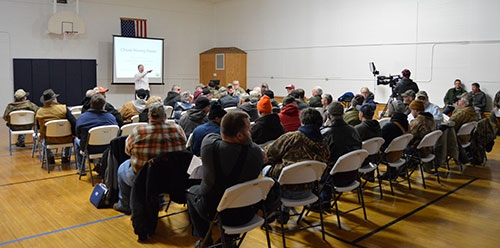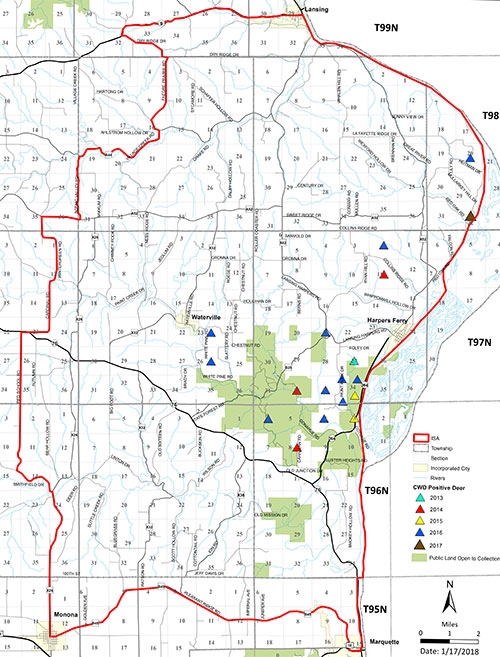You are here
Home ›DNR meets with area residents to discuss further local efforts to monitor chronic wasting disease

DNR hosts meeting regarding local CWD surveillance efforts … Nearly 60 area individuals attended the Thursday, January 18 meeting hosted by the Iowa Department of Natural Resources (DNR) to discuss local efforts to monitor chronic wasting disease (CWD). The meeting was directed by Iowa DNR Wildlife Biologist Terry Haindfield, who explained what CWD is, its impact and the more concentrated local efforts to curb the emergence of the disease in both Allamakee and Clayton counties, including a special harvest and collection effort taking place this week in an area that has been expanded even further (see accompanying map at right) since Thursday's meeting due to one newly confirmed case and five other suspected cases in Allamakee County currently undergoing their second confirmation testing since the meeting. Standard photo by Joe Moses.

Area for special CWD effort expanded ... Since its Thursday, January 18 meetings held in Allamakee County and in Clayton County, the Iowa Department of Natural Resources (DNR) has expanded the surveillance zone in Allamakee County for the current special tissue collection effort going on now until this Sunday, January 28. The map above shows that the focused collection area has now been expanded further to the north and west along Highway 9 west of Lansing and further to the south and west toward Monona in Clayton County. The expansion comes after the confirmation of at least one more case of CWD from the recent 2017 deer hunting season (indicated by the brown triangle pictured above in the most eastern tip of Allamakee County), along with five other suspected cases currently undergoing a second confirmation test. Submitted image.
Focused tissue collection zone expanded since Thursday meeting following one new confirmed CWD case and five more suspected
by Joe Moses
The Iowa Department of Natural Resources (DNR) held an informational meeting open to the public Thursday, January 18 at the Ethel Robinson Meehan Community Center in Harpers Ferry in preparation for the January 20-28 scientific deer collection effort, part of the ongoing monitoring of chronic wasting disease (CWD) in wild Iowa deer. During the public meeting, DNR Wildlife Management Biologist and CWD Coordinator Terry Haindfield conducted a presentation to approximately 60 local residents in attendance highlighting Iowa's CWD-related information and the scientific deer collection effort taking place this week in Allamakee and Clayton Counties in an effort to further monitor and combat the spread of the disease.
Haindfield discussed that CWD is a slowly progressive brain disease occurring in deer-like species including white-tailed deer, mule deer, elk, reindeer and moose and that CWD belongs to the family of diseases known as transmissible spongiform encephalopathy (TSE) or prion diseases. Haindfield explained that CWD is not caused by a virus, fungus or bacteria but is transmitted by a misshapen host protein known as a prion that is spread from animal to animal and environmentally, and at this time, no other evidence of transmission to other animals or humans has been shown.
Haindfield outlined the goals of the scientific deer collection which involve the reduction of several factors including environmental contamination, the number of potential carriers, disease transmission and the number of CWD-infected deer while involving and receiving help from local landowners and the general public in this effort. Haindfield indicated that participation is open to any Iowa resident who is able to legally hunt, has received a scientific collector permit and owns land or has permission to hunt on private land.
According to Haindfield, there are several measures that can be taken to help control CWD, including participation in this scientific collection effort by hunting and having tissue samples taken and attending public meetings to stay informed. Haindfield indicated that mineral holes and winter feeding sites are CWD transmission areas and should be covered and, if possible, soil should be removed, replaced and seeded down. The proper disposal of carcasses was another measure discussed by Haindfield as necessary to prevent the transmission of CWD.
Haindfield recommends reporting sick deer or roadkill deer by contacting local DNR Wildlife Staff or a Conservation Officer and to be aware that roadkill deer found with a slit across the throat likely have had their lymph nodes removed for CWD testing and need not be reported.
Haindfield reviewed the Center for Disease Control's (CDC's) recommendations that if a deer is harvested in an area known to have CWD-positive animals, it is strongly advisable to test the deer before consuming and to never consume an animal that has tested positive for any TSE, including CWD.
Haindfield indicated that during the special collection period, area meat lockers will be holding deer meat separately with the DNR data number that was attached to each deer killed and associated with the corresponding CWD test results.
President Tom Toycen of the Iowa Bow Hunters Association, a resident of Mt. Vernon, addressed the hunters in attendance discussing the importance of the scientific deer collection effort in Allamakee and Clayton as a measure to control and prevent the spread of CWD further west into Iowa. Toycen indicated that the rest of Iowa is looking to the hunters of this area to slow the disease down and to keep CWD cornered.
Haindfield further emphasized the importance of this collection effort in ensuring that there will be quality deer hunting available for the children, grandchildren of those in attendance and for generations to come. He further emphasized that deer hunting is an enjoyable activity and tradition that many would not like to lose.
CWD COLLECTION AREA UPDATE
Since the Thursday, January 18 meeting, the DNR has expanded the CWD Special Collection Effort area for the current collection process going on in Allamakee County through this Sunday, January 28 (see map accompanying this story on Page 1A). That area has been expanded further to the north and west along Highway 9 west of Lansing and further south and west to Monona in Clayton County following the finding of one more confirmed case of a CWD-positive deer in the very eastern portion of Allamakee County (see Page 1A map) and five other suspected cases still going through second confirmation testing.
Further information about the current collection effort, how to become a part of it, or CWD in general can be found by visiting the Permit Issuing and Check-In/Sample Stations being used for this year's collection effort. The Allamakee County station is located in the DNR Law Enforcement Building (former Allamakee County Conservation Office) at 427 North First Street in Harpers Ferry, with entrance to the building and parking in the rear of the building and a phone number of 563-379-5725. For Clayton County, that station is located at the Osborne Nature Center, located five miles south of Elkader on Highway 13 at 29862 Osborne Road with a phone number of 563-929-0070. The DNR will provide a dumpster at these same locations for carcass disposal.
Hours at both stations through this Sunday, January 28 include weekdays from 12 Noon-6:30 p.m. and both Saturday and Sunday from 8 a.m.-6:30 p.m. Sampling will continue at each location Monday, January 29 from 12 Noon-6:30 p.m.

